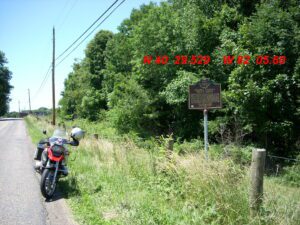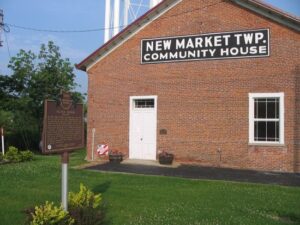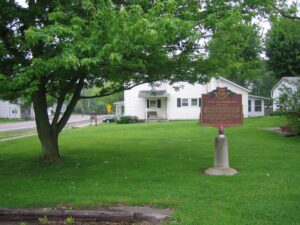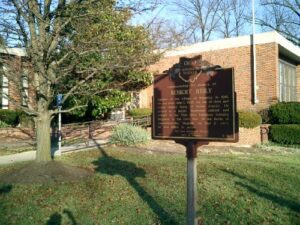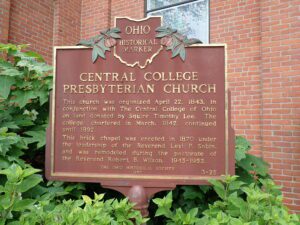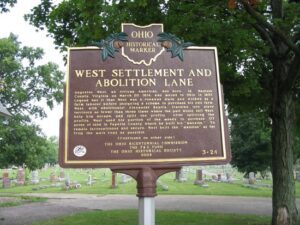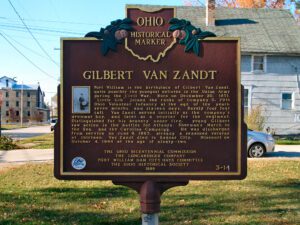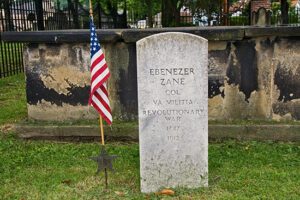, OH
On French Ridge in Richland Township, on June 5, 1863, local citizens in defiance of conscription attacked Elias Robinson, an enrolling officer of the Union Army. When Captain James Drake, the provost marshal, imprisoned the ringleaders, armed locals released them. Colonel William Wallace of the 15th Ohio Volunteer Infantry was sent to the scene with a force of 420 soldiers from Camp Chase in Columbus. On June 17, the soldiers approached the fortified camp of nearly one thousand malcontents. After firing upon the soldiers, the “rebels” scattered with only a few captured or wounded. The next morning, local Peace Democrats, led by politician Daniel P. Leadbetter, negotiated a surrender of the ringleaders. More than forty people were indicted for involvement in the rebellion, but only Lorenzo Blanchard, owner of the farm where the camp was located, was found guilty. Once this riot at “Fort Fizzle” ended, resistance to the draft in Holmes County subsided.
, OH
In 1798, Henry Massie, brother of General Nathaniel Massie, platted a town, the earliest permanent settlement in Highland County, covering 400 acres and named it New Market after a town in his native Virginia. New Market served as the unofficial county seat until Hillsboro assumed that title in 1807. Despite being traversed by the Cincinnati-Chillicothe Post Road with seven other roads (including one from Manchester) leading in, New Market ceased being an active trade and civic center. It is now a small hamlet with a cluster of dwellings, a church, and a few businesses.
, OH
Upon this site, in the late 18th and early 19th centuries, stood Chief Roundhead’s Wyandot Indian village. This flourishing agricultural community later gave way to white settlement and Hardin County’s first town was laid out here in 1832. Roundhead, or Stiahta, was celebrated for his capture of American General James Winchester during the War of 1812. Roundhead is believed to be buried in this vicinity.
, OH
Robert Reily, founder of the village of Wyoming in 1861. He was born June 1, 1820, the son of John and Nancy Hunter Reily of Butler County. He served as a major, lieutenant colonel and colonel of the 75th Ohio Volunteer Infantry Regiment in the Civil War. At the battle of Chancellorsville, Virginia, on May 2, 1863, he was killed in action.
, OH
This church was organized April 22, 1843, in conjunction with The Central College of Ohio on land donated by Squire Timothy Lee. The college, chartered in March, 1842, continued until 1892. This brick chapel was erected in 1870 under the leadership of the Reverend Levi P. Sabin, and was remodeled during the pastorate of the Reverend Robert B. Wilson, 1943-1953.
, OH
Augustus West, an African American, was born in Madison County, Virginia on March 20, 1814, and moved to Ohio in 1837. Legend has it that West was a runaway slave and worked as a farm laborer before designing a scheme to purchase his own farm. West, with abolitionist Alexander Beatty, traveled into slave territory no fewer than three times where the pair would sell West, help him escape, and split the profits. After splitting the profits, West used his portion of the money to purchase 177 acres of land in Fayette County where he built his “mansion.” To remain inconspicuous and secure, West built the “mansion” as far from the main road as possible. (continued on other side)
, OH
Port William is the birthplace of Gilbert Van Zandt, quite possibly the youngest enlistee in the Union Army during the Civil War. Born on December 20, 1851, “Little Gib” joined the ranks of Company D, 79th Ohio Volunteer Infantry at the age of ten years, seven months, and sixteen days. Barely four feet tall, Van Zandt served initially as the company’s drummer boy, and later as a courier for the regiment. Distinguished for his bravery under fire, young Gilbert saw action in the battles for Atlanta, Sherman’s March to the Sea, and the Carolina Campaign. He was discharged from service on June 9, 1865, already a seasoned veteran at thirteen. Van Zandt died in Kansas City, Missouri on October 4, 1944 at the age of ninety-two.
, OH
The Walnut Grove Cemetery is the burial place of members of the Zane and Martin families. Their graves lie within the brick enclosure. The cemetery is also the resting-place of many early Martins Ferry residents, including veterans of the Revolutionary War, the War of 1812, the Mexican War, and the Civil War. The Zane and Martin families were significant in the pioneer history of the region. Betty Zane’s legendary heroism at Fort Henry (now Wheeling, West Virginia) helped settlers resist an attack by the British and their Native American allies in September 1782. (Continued on other side)


